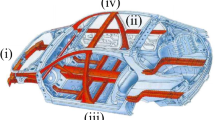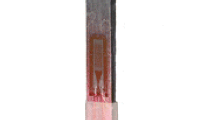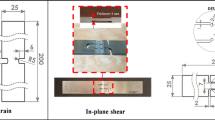Abstract
Ultra-high strength steel (UHSS) plays an important role in the automotive lightweight industry owing to its insubstantial weight and high specific strength. Roll forming is one of the effective forming processes for UHSS in the steel industry. In this study, the minimum bending radius is determined by roll forming experiments, taking into account the 1200MPa level of the V-profiled parts of UHSS. The ductile fracture criterion (DFC), which considers both the “tensile ductile fracture” and “shear ductile fracture,” is applied to predict the fracture of sheets in the roll forming process, where bending is the main deformation mode. A set of rolls is designed to investigate the fracture behavior in the roll forming process. In addition, finite element models (FEMs) are built and four sets of experiments are conducted to calibrate the fracture of the V-profiled parts for R/T = 1, 2, 3, and 4. Furthermore, the fracture time and fracture location of the V-profiled parts for R/T = 1 and 2 are predicted and the prediction results agree with the experimental results.
Similar content being viewed by others
Abbreviations
- σ :
-
equivalent stress
- K :
-
hardening coefficient
- ε 0 :
-
initial strain
- ε p :
-
equivalent plastic strain
- n :
-
hardening index
- E :
-
Young’s modulus
- r :
-
anisotropy coefficient
- σ p0.2 :
-
yield strength
- σ b :
-
tensile strength
- ε f :
-
equivalent plastic strain
- σ 1 :
-
maximum principal stress
- σ m :
-
hydrostatic pressure
- σ 3 :
-
minimum principal stress
- σ' 1 :
-
maximum principal stress deviator
- σ' 3 :
-
minimum principal stress deviator
- C 1 :
-
introduced material constant
- C :
-
ductile fracture integral value
- D :
-
damage value
References
Oh, W.-J. and Lee, C.-M., “A Study on the Sheet Forming of the Lower Seat Rail Using 1180 Trip Steel,” International Journal of Precision Engineering and Manufacturing, Vol. 19, No. 2, pp. 299–302, 2018.
Weiss, M., Marnette, J., Wolfram, P., Larrañaga, J., and Hodgson, P. D., “Comparison of Bending of Automotive Steels in Roll Forming and in a V-Die,” Key Engineering Materials, Vols. 504–506, pp. 797–802, 2012.
Mäntyjärvi, K., Merklein, M., and Karjalainen, J. A., “UHS Steel Formability in Flexible Roll Forming,” Key Engineering Materials, Vols. 410–411, pp. 661–668, 2009.
Lundberg, M. and Melander, A., “Finite Element Analysis of Roll Forming of UHSS Compared to Traditional Bending,” Proc. of IDDRG 2008 International Conference, pp. 331–338, 2008.
Badr, O. M., Rolfe, B., Zhang, P., and Weiss, M., “Applying a New Constitutive Model to Analyse the Springback Behaviour of Titanium in Bending and Roll Forming,” International Journal of Mechanical Sciences, Vol. 128, pp. 389–400, 2017.
Hudgins, A., Matlock, D., Speer, J., and Van Tyne, C., “Predicting Instability at Die Radii in Advanced High Strength Steels,” Journal of Materials Processing Technology, Vol. 210, No. 5, pp. 741–750, 2010.
Keeler, S. P. and Backofen, W. A., “Plastic Instability and Fracture in Sheets Stretched over Rigid Punches,” ASM Transactions Quarterly, Vol. 56, No. 1, pp. 25–48, 1963.
Goodwin, G. M., “Application of Strain Analysis to Sheet Metal Forming Problems in the Press Shop,” SAE Transactions, Vol. 77, Section 1, pp. 380–387, 1968.
Centeno, G., Bagudanch, I., Martínez-Donaire, A. J., Garcia-Romeu, M. L., and Vallellano, C., “Critical Analysis of Necking and Fracture Limit Strains and Forming Forces in Single-Point Incremental Forming,” Materials & Design, Vol. 63, pp. 20–29, 2014.
Hussaini, S. M., Krishna, G., Gupta, A. K., and Singh, S. K., “Development of Experimental and Theoretical Forming Limit Diagrams for Warm Forming of Austenitic Stainless Steel 316,” Journal of Manufacturing Processes, Vol. 18, pp. 151–158, 2015.
Ju, L., Mao, T., and Li, H., “An Experimental and Numerical Study of Forming Limits of AA5182-O,” The International Journal of Advanced Manufacturing Technology, Vol. 79, Nos. 1–4, pp. 221–228, 2015.
Min, J., Lin, J., and Li, J., “Forming Limits of Mg Alloy ZEK100 Sheet in Preform Annealing Process,” Materials & Design, Vol. 53, pp. 947–953, 2014.
Zeng, D., Chappuis, L., Xia, Z.C., and Zhu, X., “A Path Independent Forming Limit Criterion for Sheet Metal Forming simulations,” SAE International Journal of Materials and Manufacturing, Vol. 1, No. 1, pp. 809–817, 2009.
Wang, H., Yan, Y., Jia, F., and Han, F., “Investigations of Fracture on DP980 Steel Sheet in Roll Forming Process,” Journal of Manufacturing Processes, Vol. 22, pp. 177–184, 2016.
Sriram, S., Wong, C., Huang, M., and Yan, B., “Stretch Bendability of Advanced High Strength Steels,” SAE Technical Paper, No. 2003-01-1151, 2003.
Hora, P., Tong, L., Gorji, M., Manopulo, N., and Berisha, B., “Significance of the Local Sheet Curvature in the Prediction of Sheet Metal Forming Limits by Necking Instabilities and Cracks,” Proc. of MATEC Web of Conferences, Vol. 80, Article No. 11003, 2016.
Ozturk, F. and Lee, D., “Analysis of Forming Limits Using Ductile Fracture Criteria,” Journal of Materials Processing Technology, Vol. 147, No. 3, pp. 397–404, 2004.
Zeng, D., Xia, Z. C., Shih, H.-C., and Shi, M. F., “Development of Shear Fracture Criterion for Dual-Phase Steel Stamping,” SAE Technical Paper, No. 2009-01-1172, 2009.
Luo, M. and Wierzbicki, T., “Numerical Failure Analysis of a Stretch-Bending Test on Dual-Phase Steel Sheets Using a Phenomenological Fracture Model,” International Journal of Solids and Structures, Vol. 47, Nos. 22–23, pp. 3084–3102, 2010.
Li, H., Fu, M. W., Lu, J., and Yang, H., “Ductile Fracture: Experiments and Computations,” International Journal of Plasticity, Vol. 27, No. 2, pp. 147–180, 2011.
Huang, X. Z., Chen, J. S., and Chen, J., “Review on Fracture Criterion of Sheet Metal Forming,” Chinese Journal of Mechanical Engineering, Vol. 47, No. 4, pp. 23–31, 2011.
Wang, P. and Qu, S., “Analysis of Ductile Fracture by Extended Unified Strength Theory,” International Journal of Plasticity, Vol. 104, pp. 196–213, 2018.
Dizaji, S. A., Darendeliler, H., and Kaftanoğlu, B., “Prediction of Forming Limit Curve at Fracture for Sheet Metal Using New Ductile Fracture Criterion,” European Journal of Mechanics-A/Solids, Vol. 69, pp. 255–265, 2018.
Li, S., He, J., Gu, B., Zeng, D., Xia, Z. C., Zhao, Y., and Lin, Z., “Anisotropic Fracture of Advanced High Strength Steel Sheets: Experiment and Theory,” International Journal of Plasticity, Vol. 103, pp. 95–118, 2018.
Jackiewicz, J., “Use of a Modified Gurson Model Approach for the Simulation of Ductile Fracture by Growth and Coalescence of Microvoids Under Low, Medium and High Stress Triaxiality Loadings,” Engineering Fracture Mechanics, Vol. 78, No. 3, pp. 487–502, 2011.
Roth, C. C. and Mohr, D., “Ductile Fracture Experiments with Locally Proportional Loading Histories,” International Journal of Plasticity, Vol. 79, pp. 328–354, 2016.
Deole, A. D., Barnett, M. R., and Weiss, M., “The Numerical Prediction of Ductile Fracture of Martensitic Steel in Roll Forming,” International Journal of Solids and Structures, Vols. 144–145, pp. 20–31, 2018.
Oh, S. I., Chen, C. C., and Kobayashi, S., “Ductile Fracture in Axisymmetric Extrusion and Drawing—Part 2: Workability in Extrusion and Drawing,” Journal of Engineering for Industry, Vol. 101, No. 1, pp. 23–35, 1979.
Brozzo, P., Deluca, B., and Rendina, R., “A New Method for the Prediction of Formability Limits in Metal Sheets, Sheet Metal Forming and Formability,” Proc. of the 7th Biennial Conference of the International Deep Drawing Research Group, 1972.
Rice, J. R. and Tracey, D. M., “On the Ductile Enlargement of Voids in Triaxial Stress Fields?” Journal of the Mechanics and Physics of Solids, Vol. 17, No. 3, pp. 201–217, 1969.
Huang, J.-K. and Dong, X.-H., “Numerical Simulation and Experimental Verification of Ductile Fracture Criteria of Metals,” Materials Science and Technology, Vol. 18, No. 4, pp. 450–454, 2010.
Author information
Authors and Affiliations
Corresponding author
Additional information
Fei Han Professor in the School of Mechanical and Materials Engineering, North China University of Technology. His research interest is theoretical study on roll forming process of sheet metal.
Yun Wang M.Sc. candidate in the School of Mechanical and Materials Engineering, North China University of Technology. His research interest is theoretical study on roll forming process of sheet metal.
Zai-Lin Wang M.Sc. candidate in the School of Mechanical and Materials Engineering, North China University of Technology. His research interest is theoretical study on roll forming process of sheet metal.
Rights and permissions
About this article
Cite this article
Han, F., Wang, Y. & Wang, ZL. Mechanical Bending Property of Ultra-High Strength Steel Sheets IN Roll Forming Process. Int. J. Precis. Eng. Manuf. 19, 1885–1893 (2018). https://doi.org/10.1007/s12541-018-0216-7
Received:
Revised:
Accepted:
Published:
Issue Date:
DOI: https://doi.org/10.1007/s12541-018-0216-7




